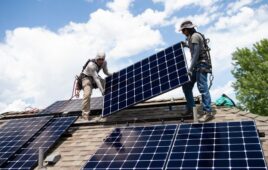PV rapid shutdown requirements were added to NEC 2014 (690.12) to improve electrical and fire safety hazards, namely for first responders. Conductors associated with PV systems may remain energized even after the electrical service disconnect has been opened. To alleviate this risk, the NEC has put in place specific requirements to de-energize conductors extending from a PV array.

Residential examples
PV system circuits installed in or on buildings must include a rapid shutdown function that is in accordance with NEC 2014, Article 690.12. Requirements include:
- Rooftop PV installations.
- Conductors which extend greater than 10 ft from the array (outside) or more than 5 ft inside a building are required to be de-energized upon command of shutdown.
- These conductors must be de-energized to below 30 V and 240 VA within 10 seconds of initiating rapid shutdown.
- Correct stickers and/or signage shall identify the rapid shutdown initiation method.
- All PV equipment performing the rapid shutdown shall be listed and identified.
PV equipment location should be carefully considered when installing a rapid-shutdown-compliant system. Below are examples on how compliance can be achieved for systems of various sizes.

Commercial example
Residential PV Systems
For a residential system, rapid shutdown compliance can be achieved by the following means:
- Use of a rapid-shutdown-complaint combiner installed within 10 ft of the array to de-energize conductors extending from the array to the inverter (Example 1).
- Inverter installed indoors with no more than 5 ft of conductors inside the building (Example 2).
- Inverter installed outside within 10ft of the array (Example 3).
Commercial PV Systems (String Inverters)
For commercial systems, rapid shutdown compliance is achieved when three-phase string inverters are placed within 10 ft of array (equipment outside) or within 5 ft of array (equipment inside).

Utility example
Utility PV Systems (Central Inverters)
For utility projects or systems utilizing three-phase central inverters, rapid shutdown compliance is achieved through rapid-shutdown-compliant combiner boxes installed at the array.
This article is contributed by Michael Nieman, applications engineer with Yaskawa – Solectria Solar.





Hello,
I have 6 85 watt 18 volt panels. No invertors on roof or in panels. I am wiring them to pairs of 24 volts 170 watts. Total coming off roof will be 24 volts at 22 amps. My question is do I need a rapid shutdown or just a disconnect outside on the wall within ten feet of the PV array?